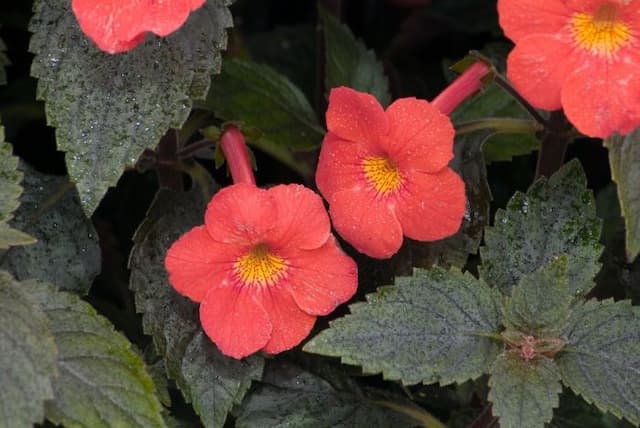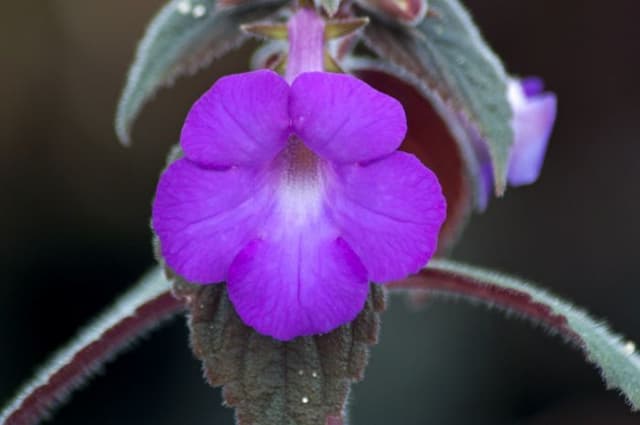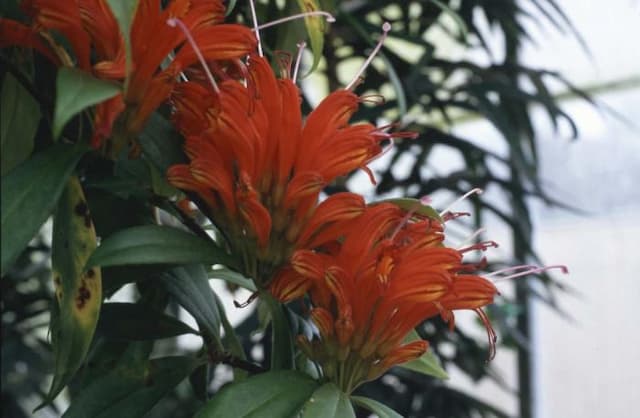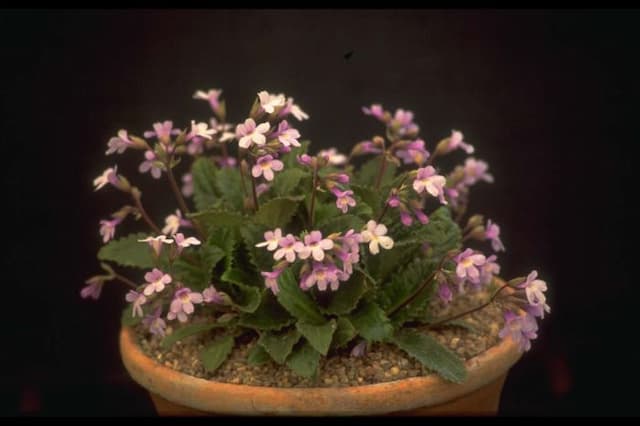Cape Primrose Streptocarpus 'Leyla' (PBR)

ABOUT
Streptocarpus 'Leyla' is a flowering plant known for its striking and ornate blooms. The flowers of 'Leyla' are characterized by their vibrant color palette, typically showcasing shades of purple, blue, or violet, often adorned with contrasting yellow or white throats that add a dazzling effect to their already charming appearance. These blossoms have a funnel-like shape, extending elegantly from the base and flaring out into five distinct lobes that may exhibit waves or ruffles along their edges, adding a touch of grace and movement. The plant itself forms a lush rosette of elongated, velvety leaves with a deep green hue that provides a perfect backdrop for the floral display. The foliage tends to have a soft, almost fuzzy texture, inviting to the touch, and they grow in a dense cluster at the base of the plant. The contrast between the rich green leaves and the brilliant flowers makes 'Leyla' a captivating presence in any indoor plant collection or as a component in shaded garden beds where its bloom can truly shine without the full intensity of direct sunlight. Streptocarpus 'Leyla' has a reputation for being a generous bloomer, often producing a succession of flowers over an extended period. The overall impression of the plant is one of lushness and vibrant color, making it a beloved choice for those wishing to add a touch of nature's splendor to their surroundings.
About this plant
 Names
NamesFamily
Gesneriaceae.
Synonyms
Cape Primrose, African Violet.
Common names
Streptocarpus 'Leyla' (PBR)
 Toxicity
ToxicityTo humans
The Cape primrose, commonly referred to in this context, is not considered toxic to humans. There are no commonly reported symptoms of poisoning for ingestion of Cape primrose plants, as they are generally recognized as non-toxic.
To pets
The Cape primrose is also generally considered non-toxic to pets. There are no well-documented symptoms of poisoning for animals such as cats and dogs from ingestion of this plant. However, it is always advised to prevent pets from eating houseplants, as individual sensitivity can vary, and ingestion might lead to mild gastrointestinal upset out of an abundance of caution.
 Characteristics
CharacteristicsLife cycle
Perennials
Foliage type
Evergreen
Color of leaves
Varies
Flower color
Varies
Height
6 inches (15 cm)
Spread
18 inches (45 cm)
Plant type
Herb
Hardiness zones
10
Native area
Africa
Benefits
 General Benefits
General Benefits- Easy to care for: Streptocarpus 'Leyla' is low maintenance and does not require extensive gardening skills.
- Long blooming period: It produces flowers for most of the year, providing continuous color in indoor or shaded garden settings.
- Vibrant colors: The flowers of Cape Primrose offer a variety of striking colors, adding beauty to any space.
- Compact growth: Ideal for smaller spaces such as windowsills or apartments since it has a compact, manageable growth habit.
- Shade tolerant: This plant thrives in shaded areas where other flowering plants might struggle to bloom.
 Medical Properties
Medical PropertiesThis plant is not used for medical purposes.
 Air-purifying Qualities
Air-purifying QualitiesThis plant is not specifically known for air purifying qualities.
 Other Uses
Other Uses- Edible Garnish: Some Streptocarpus flowers can be used as an edible garnish to add a splash of color to salads and desserts, though it's important to ensure they are free from pesticides and are known to be safe for consumption.
- Photography Subjects: With their unique shapes and vibrant colors, these flowers provide excellent subjects for macro photography and botanical illustration.
- Humidity Indicator: In conditions that are overly dry, the Streptocarpus will show signs of wilting, serving as a natural indicator that the surrounding environment requires more humidity.
- Art Inspiration: The intricate patterns and bold colors of Streptocarpus flowers can inspire designs in various types of art, from watercolor paintings to fabric prints.
- Learning Tool: These plants can be used in educational settings to teach children or beginners about plant care and propagation techniques.
- Fairy Gardens: Due to their size and foliage, Streptocarpus can be incorporated into fairy gardens for a touch of whimsy and scale-appropriate plant life.
- Color Therapy: The rich colors of the Streptocarpus blooms can be used in color therapy sessions to promote relaxation and well-being.
- Scented Drawer Liners: The foliage, when dried and subtly scented, can be used to line drawers and freshen up clothing storage spaces with a mild fragrance.
- Event Placecards: Small Streptocarpus leaves can be used as creative place cards for events, with names written on the leaves for a botanical touch.
- Collage Material: Pressed flowers and leaves from the Streptocarpus can be used in making collages and other paper-based crafts.
Interesting Facts
 Feng Shui
Feng ShuiThe Cape Primrose is not used in Feng Shui practice.
 Zodiac Sign Compitability
Zodiac Sign CompitabilityThe Cape Primrose is not used in astrology practice.
 Plant Symbolism
Plant Symbolism- Enduring Love: Streptocarpus, commonly known as Cape Primrose, often symbolizes a long-lasting bond or affection, much like the plant's ability to bloom repeatedly over an extended period.
- Resilience: Cape Primrose is known for its durability and ability to thrive in less-than-ideal conditions, making it emblematic of resilience and adaptability in the face of challenges.
- Hope and New Beginnings: With its continual flowering habit, Cape Primrose is often associated with hope, renewal, and the start of new endeavors or phases in life.
 Water
WaterCape primrose, commonly known as Streptocarpus, should be watered when the top inch of soil feels dry to the touch. This might mean watering once every week or more frequently, depending on environmental conditions like heat and humidity. Use lukewarm water and pour it directly onto the soil, avoiding the leaves, with about 8-12 ounces per watering session for a standard 6-inch pot. Watering should be reduced in the winter months to prevent soggy soil, thereby avoiding root rot.
 Light
LightCape primrose prefers bright, indirect light, making an east-facing window with morning light or a few feet away from a south-facing window ideal spots. Direct sunlight can scorch the leaves, so it's crucial to provide filtered light. In low-light conditions, the plant may produce fewer flowers, so proper lighting is essential for optimal blooming.
 Temperature
TemperatureThe ideal temperature range for Cape primrose is between 60 and 75 degrees Fahrenheit. It can survive minimum temperatures of 50 degrees Fahrenheit and maximum temperatures of about 80 degrees Fahrenheit. Keeping the plant in this range will promote good growth and flowering.
 Pruning
PruningTo encourage bushy growth and more blooms, regularly pinch back the tips of Cape primrose and remove any spent flowers or yellowing leaves. Prune lightly throughout the growing season as needed, and perform a more thorough pruning in early spring to rejuvenate older plants. Pruning at the start of the growing season allows the plant to focus its energy on producing fresh, healthy growth.
 Cleaning
CleaningAs needed
 Soil
SoilCape Primrose, including the variety 'Leyla', thrives in a well-draining soil mix with high organic matter. A popular recipe for its potting mix includes one part peat moss or coco coir, one part perlite or vermiculite, and one part fine bark to ensure sufficient drainage and aeration. The preferred soil pH for Cape Primrose is slightly acidic to neutral, ranging from 6.0 to 7.0. Regularly check the soil moisture as these plants like to be kept moderately moist but not waterlogged.
 Repotting
RepottingCape Primroses, like 'Leyla', should be repotted every 12 to 18 months or when the plant has outgrown its current pot. It is best to repot in spring or early summer to take advantage of the plant's active growth period, which will help it settle into its new pot more easily. Use fresh potting mix and a pot that is slightly larger than the current one to give the roots room to grow.
 Humidity & Misting
Humidity & MistingCape Primrose prefers a moderate to high humidity level, typically around 50-60%. To maintain these conditions, it is beneficial to place a humidity tray beneath the plant or use a room humidifier, especially during dry winter months or in arid climates. Avoid misting as it can promote fungal disease on the leaves.
 Suitable locations
Suitable locationsIndoor
Place in bright, indirect light; avoid direct sun.
Outdoor
Requires shade and shelter; not frost tolerant.
Hardiness zone
10-11 USDA
 Life cycle
Life cycleThe life cycle of Streptocarpus 'Leyla', commonly known as Cape Primrose, begins with the sowing of seeds or the propagation of leaf cuttings. The seeds germinate, typically within a few weeks, and the emerging seedlings grow into rosettes of leaves, a stage during which they require warm temperatures and consistent moisture. After a few months, young plants reach maturity and start producing their characteristic tubular flowers that come in various shades including the unique colorations of the 'Leyla' cultivar, with this blooming phase recurring multiple times in favorable conditions. Cape Primrose will often enter a period of dormancy, especially when temperatures drop or during shorter winter days; during this time, plant growth slows and watering should be reduced. Following dormancy, with the return of warmer temperatures and longer daylight hours, they resume active growth and repeat the flowering cycle. With proper care, Streptocarpus 'Leyla' can live for several years, continuously repeating the growth, dormancy, and blooming phases.
 Propogation
PropogationPropogation time
Spring-Early Summer
The most popular method of propagating Streptocarpus 'Leyla' is through leaf cuttings. This is best done in the late spring to early summer when the plant is actively growing. A healthy, mature leaf is selected and cut across the main vein at an angle. The cutting is then placed in a well-draining potting mix, ensuring that the cut vein touches the soil. The pot is covered with plastic to maintain humidity and placed in bright, indirect light. It is important to keep the soil moist but not waterlogged. Roots and new shoots will typically develop from the vein in a few weeks, after which the young plants can be potted up separately.









